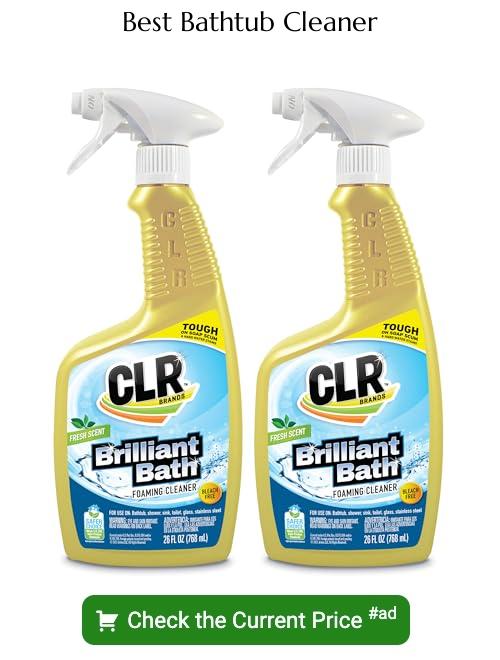Last updated on
Dive into this comparison guide as we dissect the realities of steel tubs vs fiberglass because knowing the advantages and drawbacks of each can transform your bathroom renovation decision-making.
Key takeaways:
- Steel tubs are durable and resistant to scratches and impacts.
- Fiberglass tubs are lightweight and can last up to 15 years.
- Steel tubs require regular maintenance to prevent rust.
- Fiberglass tubs are easy to clean and repair.
- Steel tubs retain heat better, while fiberglass tubs offer superior insulation and comfort.
Comparison of Material Constructions: Steel Tub Vs. Fiberglass Tub
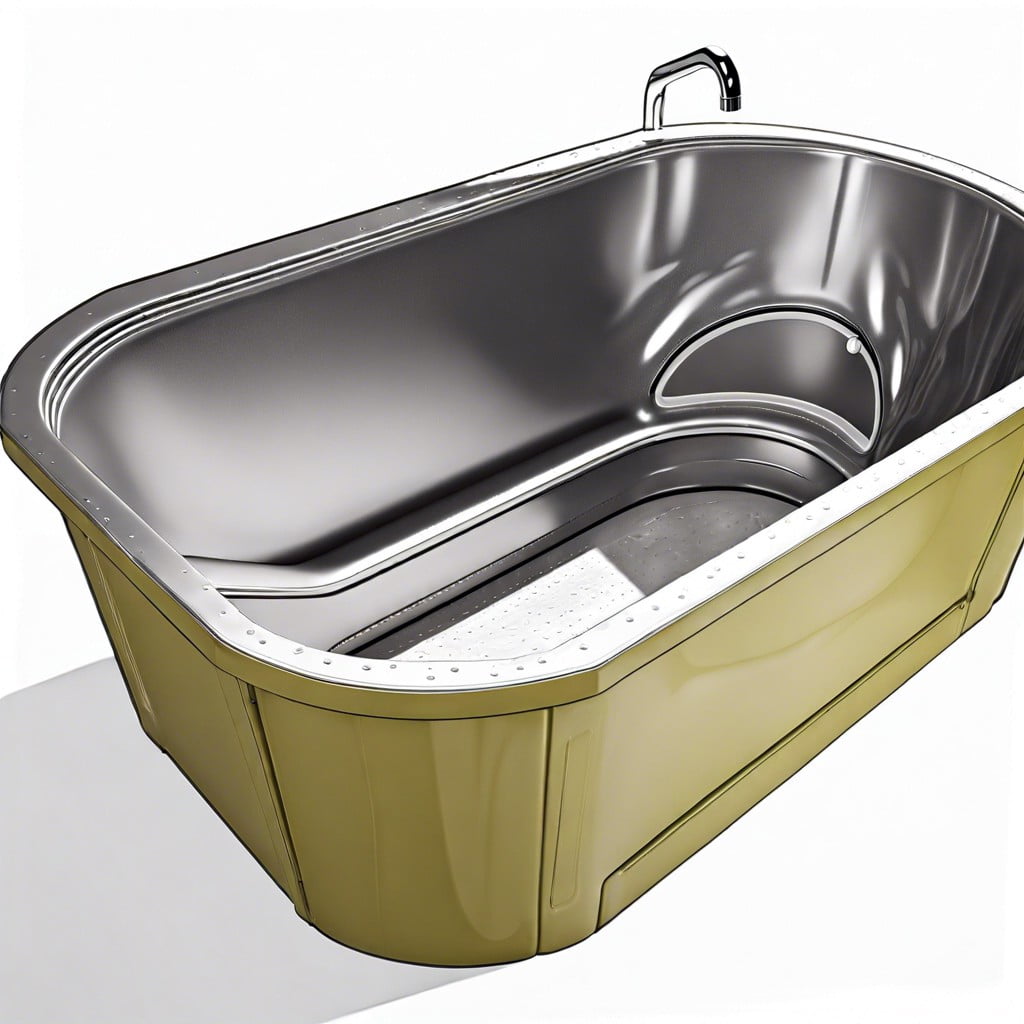
Understanding the foundational characteristics of steel and fiberglass goes a long way in determining the best tub for your bathroom sanctuary.
Steel tubs are heavyweight contenders, known for their robust construction; they’re crafted from a sheet of steel with a protective porcelain enamel coating, offering that classic, glossy finish.
On the flip side, fiberglass tubs are created by forming layers of fiberglass into the desired shape and then coating it with resin for smoothness. This results in a much lighter but less rigid structure.
While both materials have their own set of benefits, remember that the choice often comes down to your personal needs—whether you prioritize durability over ease of installation, or cost-effectiveness above all else.
Durability and Strength of Steel Tubs
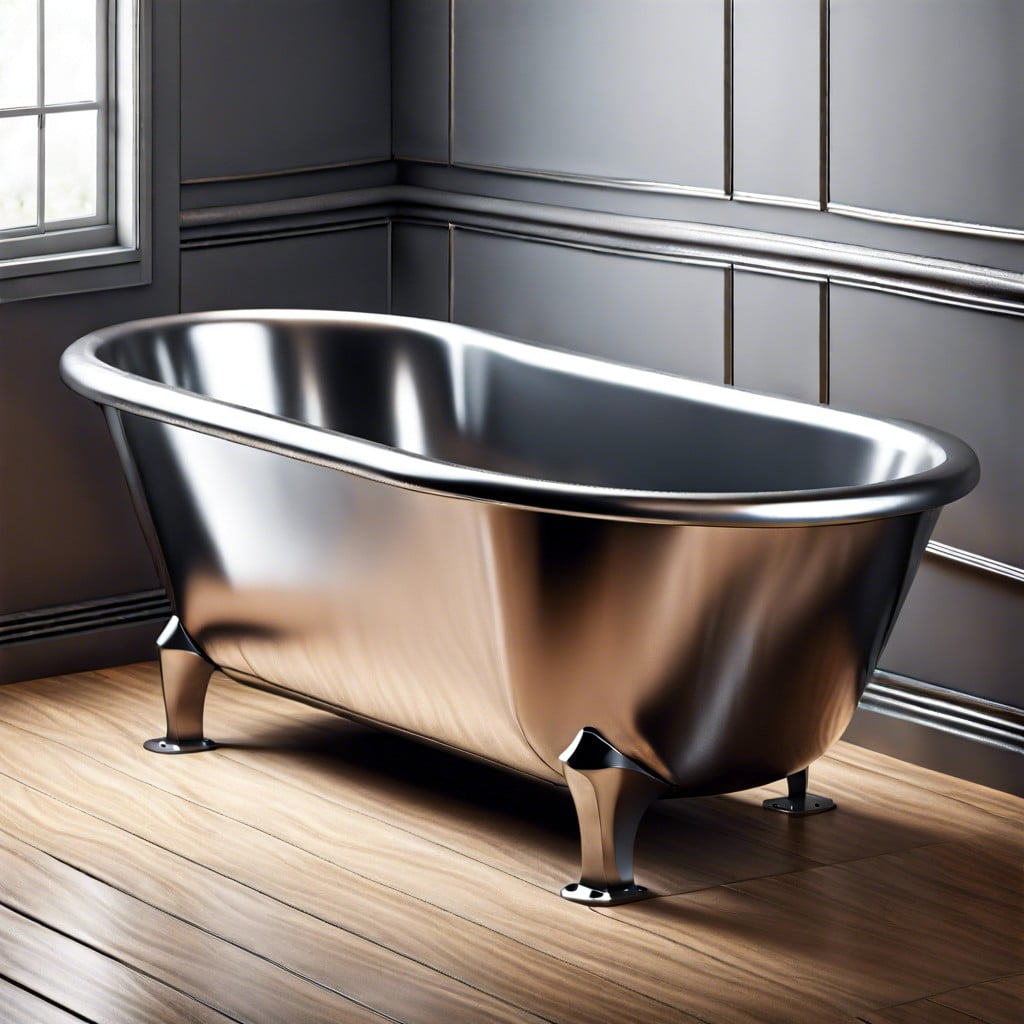
Steel tubs are synonymous with enduring quality. These baths are often made from porcelain-enameled steel, which combines the strength of steel with a glass-based, porcelain coating. The result is a scratch and impact-resistant surface that can handle the rigors of daily use without chipping easily.
Moreover, steel’s robust construction resists warping and cracking, ensuring your tub maintains its shape over the years. It’s not just about longevity though; steel also supports heavy weights comfortably, making it ideal for a sumptuous soak.
Despite the toughness, they are susceptible to rust if the porcelain layer is compromised, so proper care is vital to preserve their lifespan.
Durability and Lifespan of Fiberglass Tubs
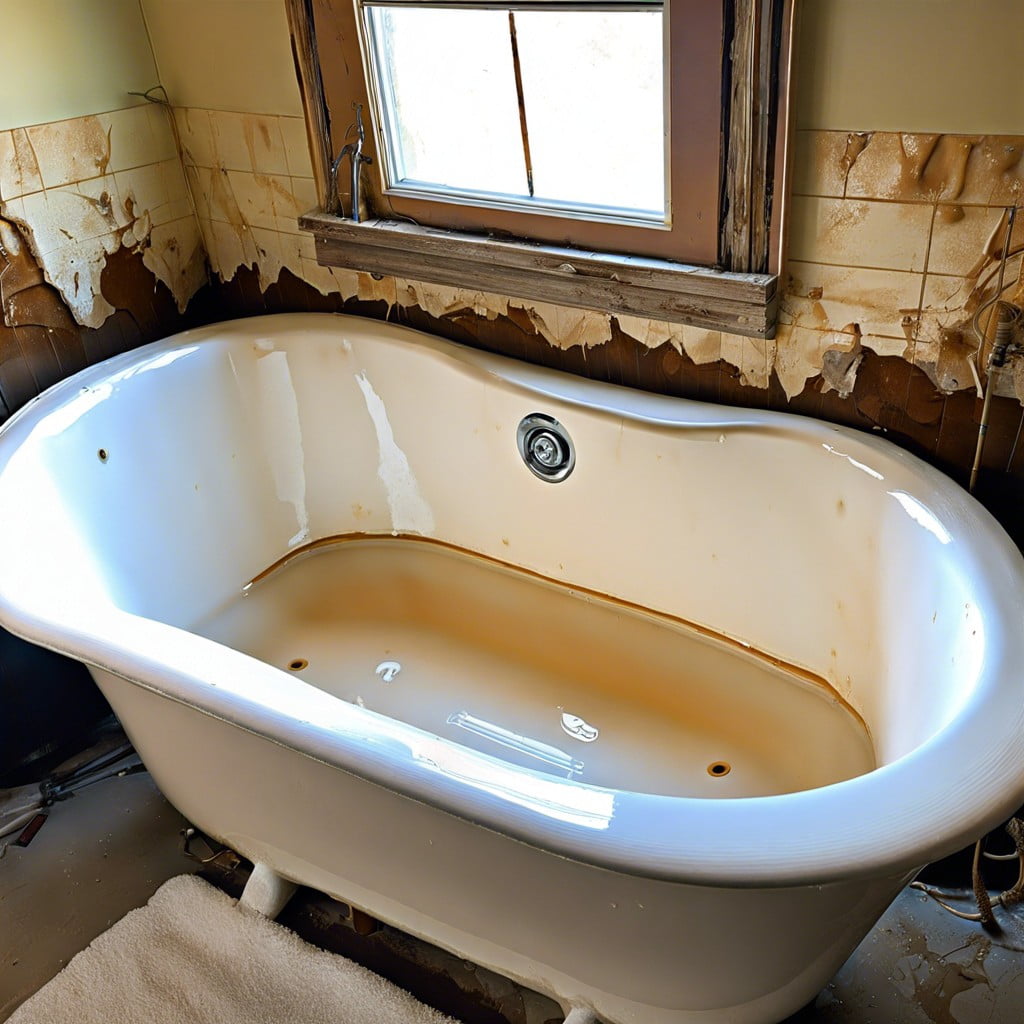
Fiberglass tubs, although lightweight, come with a good measure of resilience. Crafted from layers of woven glass fibers bonded with resin, they withstand daily wear quite well.
Yet, it’s worth noting that they’re prone to scratching and may show signs of wear sooner than their steel counterparts.
With proper care, including gentle cleaners and avoiding abrasive materials, these tubs can serve you comfortably for up to 15 years.
The surface may dull and discolor over time, but this is a natural process that can often be buffed out or refinished, extending your tub’s life and keeping it looking fresh.
Maintenance Requirements for Steel Tubs
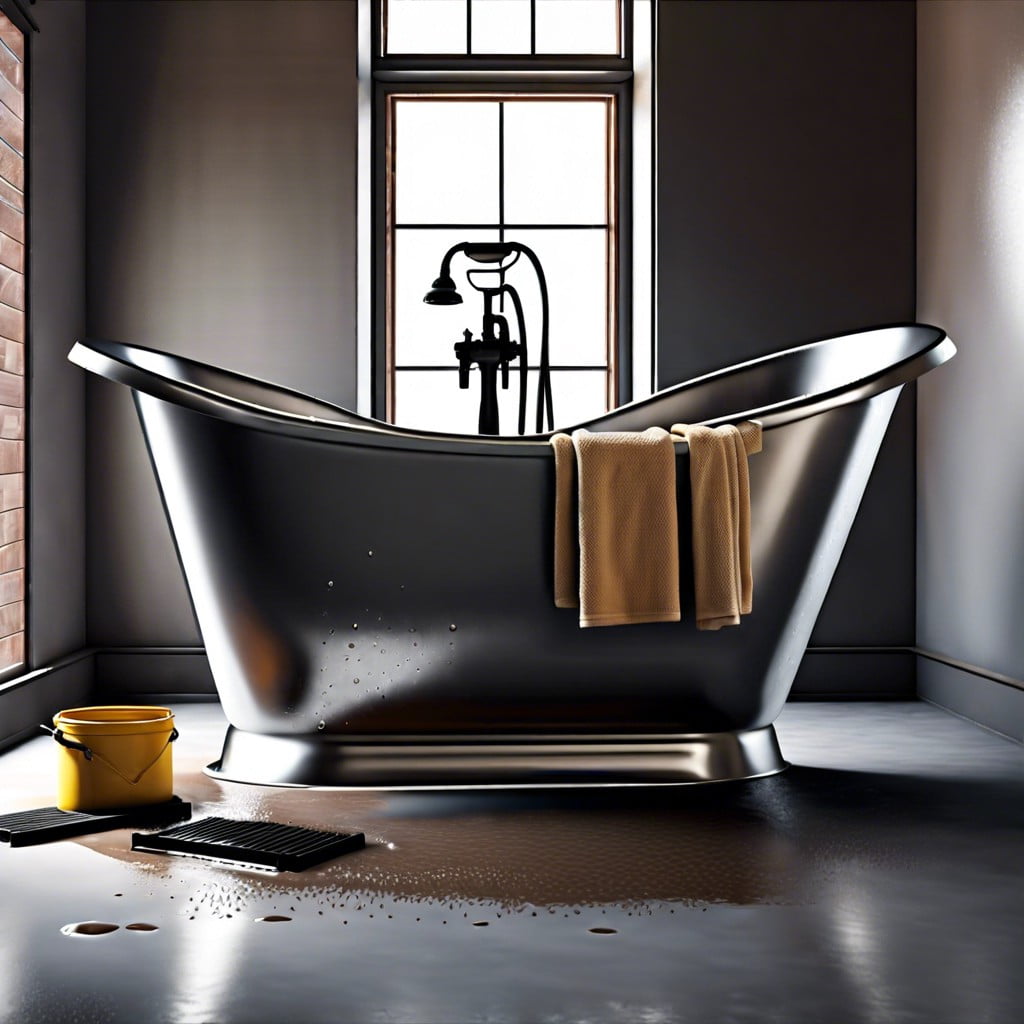
Caring for a steel tub is straightforward, ensuring longevity and luster. Use gentle, non-abrasive cleaners to avoid scratching the surface. Regular cleaning prevents mineral deposits and soap scum build-up.
Unlike other materials, be cautious with certain acidic cleaners that may damage the steel’s protective coating. To deal with minor scratches, applying a specialized cream can often diminish their appearance. With consistent, simple maintenance, your steel tub will retain its elegance and functionality for years.
Ease of Maintenance for Fiberglass Tubs
Fiberglass tubs boast a non-porous finish that resists staining and makes cleaning a breeze. A simple wipe with a gentle cleaner keeps them looking pristine.
It’s important to avoid abrasive cleaners, which can damage the surface. The lightweight material also translates to less structural stress on floor joists, minimizing long-term maintenance related to installation strain.
Moreover, any minor scratches or dents they may acquire over time can be easily patched with a repair kit, making for a convenient and cost-effective maintenance solution.
Installation Process for Steel and Fiberglass Tubs
Installing a steel tub typically requires a stronger support framework due to its heavier weight. It’s essential for the floor to be structurally sound to handle the mass. Professional help is often recommended, given the nuances in handling and positioning the tub without causing damage to the bathroom’s finish.
In contrast, a fiberglass tub is much lighter and easier to maneuver. This can often lead to a more straightforward installation process, potentially manageable without professional assistance. One should still be cautious of the tub’s surface during installation to prevent scratches or cracks. Additionally, both types may require plumbing adjustments, a level surface, and sealing, but the lighter weight of fiberglass can simplify these steps. It’s pivotal to follow manufacturer instructions closely for either type to ensure proper installation and function.
Cost Analysis for Steel and Fiberglass Tubs
Steel tubs are often priced higher due to the material costs and the complexity of their construction. They tend to be a long-term investment, appreciated for their sturdiness and classic appeal.
In contrast, fiberglass tubs are generally more budget-friendly, offering good quality at a lower price point. The material’s flexibility allows for a variety of shapes and sizes at a reduced manufacturing cost, which translates to savings for the consumer.
It’s worth noting that the initial purchase price is not the only cost factor. Consider long-term expenses such as maintenance and the potential need for repairs; steel is robust but may require refinishing, while fiberglass can be easier to scratch but simpler to repair.
Additionally, think about installation costs. Steel tubs can be heavy, potentially requiring structural reinforcement, whereas fiberglass options are lightweight and can often be installed without additional support, saving on labor and materials.
Balancing upfront costs with potential long-term expenditures will help in making an informed decision that aligns with your budget and expectations.
Heat Retention Properties of Steel Tubs
Steel is inherently robust at conducting heat, which influences how quickly your bathwater might cool down. Unlike acrylic or fiberglass, metal rapidly absorbs the temperature from the water, initially cooling the bath more swiftly.
However, once the steel itself warms up, it’s excellent at retaining that warmth, keeping the water at a steady, toasty temperature for extended periods. To further enhance this effect, some steel bathtubs come equipped with built-in insulating layers that improve heat retention even more, ensuring your lengthy soaks are as warm at the end as when you first dipped in.
If you prefer leisurely baths and the idea of water retaining its heat is appealing, a steel tub might be a good investment.
Insulation and Comfort Features of Fiberglass Tubs
Fiberglass tubs offer superior insulation compared to their steel counterparts, ensuring your bath stays warmer for longer periods. This material does a fantastic job at retaining heat, which means you can enjoy a leisurely soak without the need for frequent top-ups with hot water.
When it comes to comfort, the slightly textured surface provides a non-slip quality, offering an extra measure of safety and peace of mind during your daily routine. Moreover, the material’s inherent flexibility translates into a gentler feel against the skin for a more pleasant bathing experience.
Additionally, these tubs come with a variety of customizable options, like built-in armrests and contoured back supports, enhancing the overall comfort level. The warm-to-the-touch nature of fiberglass also means no more cold shocks when leaning against the tub sides.
Design and Aesthetics: Available Styles of Both Tubs
Steel tubs often evoke a classic, vintage appeal, ideal for those looking to instill a traditional or retro vibe in their bathroom. They come in an array of enamel finishes, supporting various color choices to match your decor.
Fiberglass tubs, on the other hand, boast modernity and flexibility in design. They can be molded into numerous shapes, ranging from standard rectangles to more organic forms that can fit into unique spaces or provide ergonomic advantages.
Both materials allow for customization with fixtures and features, such as jet systems or specialized drains, giving homeowners the ability to tailor their bath experience. However, fiberglass might edge out on innovation due to its molding process, which caters to the latest trends and creative outlines that challenge conventional tub shapes.
Environmental Impact and Sustainability Considerations
When considering environmental impact and sustainability, steel tubs boast recyclability. Most steel products, including tubs, can be melted down and reshaped into new items without loss of quality, supporting a circular economy. On the flip side, while fiberglass tubs aren’t typically recyclable due to their resinous composition, they do tend to weigh less which makes them less energy-intensive to transport. This can reduce carbon emissions related to shipping.
Evaluation of resources used in manufacturing reveals that producing fiberglass can involve hazardous chemicals, necessitating careful handling and disposal practices to mitigate environmental harm. Conversely, steel production is energy-intensive, with a larger carbon footprint, but advancements in technology are improving efficiency and reducing emissions in the steel industry.
In terms of long-term sustainability, the longevity of a tub must be considered. A tub that lasts longer reduces the frequency of replacement, thus lessening cumulative material use and waste over time.
Popular Brands and Models of Steel and Fiberglass Tubs
When selecting a steel or fiberglass tub, brand reputation and model features play a crucial role. For steel tubs, Kohler stands out with options like the enameled cast iron Bellwether, known for its durability and classic design. Another respected name, American Standard, offers products such as the Cambridge, which is praised for its sturdiness and Americast engineered steel.
On the fiberglass front, manufacturers like Bootz Industries present models like the Aloha, merging affordability with quality. Delta is another noteworthy brand, with their Classic 400 model being a hit for its easy installation and comfortable contouring.
It’s worth looking out for warranty offerings and customer reviews for real-world performance insights to inform your choice. Remember to consider which models best fit your space, preferences, and usage patterns to find the perfect match for your bathroom sanctuary.
Corrosion Resistance of Steel Tubs
Steel tubs, when properly coated, exhibit excellent resistance to corrosion, which stands as a testament to their durability. The protective layer, often porcelain enamel, acts as a barrier against rust and the wear and tear from cleaning agents.
It’s crucial, however, to ensure the enamel coat remains intact; chipping may expose the steel underneath to moisture, leading to potential rusting. Regular cleaning with non-abrasive materials can help maintain the integrity of this protective enamel.
Factors such as water hardness and pH balance can also affect corrosion rates, so using water softeners can be beneficial in hard water areas to preserve the life of a steel tub.
Damage Resistance and Repair for Fiberglass Tubs
Fiberglass tubs are praised for their resilience against small impacts, which helps in avoiding cracks and chips from daily use. However, if damage does occur, the beauty of fiberglass lies in the relative ease of repair. Simple DIY kits can fix minor scratches and dents, seamlessly blending the repair with the tub’s original finish.
For more extensive damages, professional services are available that can restore the tub to its former glory, often at a lower cost than replacing the entire unit. Regular cleaning with non-abrasive cleaners also prevents long-term wear, keeping your fiberglass tub looking as good as new for years to come.
Weight Considerations for Installation and Support
Steel tubs present a significant weight that may necessitate reinforced flooring, especially in older homes where joists may not support the heft.
Professional assessment is key before installation to ensure structural integrity.
Fiberglass options, conversely, are lightweight, allowing for hassle-free placement in most bathroom settings without additional support.
This distinction notably impacts not only installation ease but also influences potential relocation flexibility and overall project timeline.
FAQ
Which is better steel or fiberglass tub?
Considering durability and longevity, steel tubs hold an advantage over acrylic tubs.
Are steel tubs any good?
Steel tubs, while requiring careful handling due to less resistance to chips and scratches, make an excellent choice, offering a beautiful finish and promising many years of use like a carefully used automobile.
What is the best material for a bathtub?
Cast iron is often regarded as the most durable material for a bathtub, while acrylic is typically seen as the easiest to maintain.
What tub is better acrylic or steel?
Steel tubs are superior to acrylic ones as they offer increased durability, strength, and have the ability to retain water heat for longer periods.
How do the durability and longevity compare between steel and fiberglass tubs?
Steel tubs tend to be more durable and longer-lasting than fiberglass tubs.
In terms of maintenance and cleaning, which is more convenient, a steel tub or a fiberglass one?
When it comes to maintenance and cleaning, a fiberglass tub is more convenient due to its resistance to stains, mold, and mildew, unlike a steel tub that may rust over time.
How do steel and fiberglass tubs vary in terms of installation and costs?
Steel tubs, although cheaper, require more effort to install due to their weight, while fiberglass tubs are lighter and easier to install but tend to cost more.
Recap
